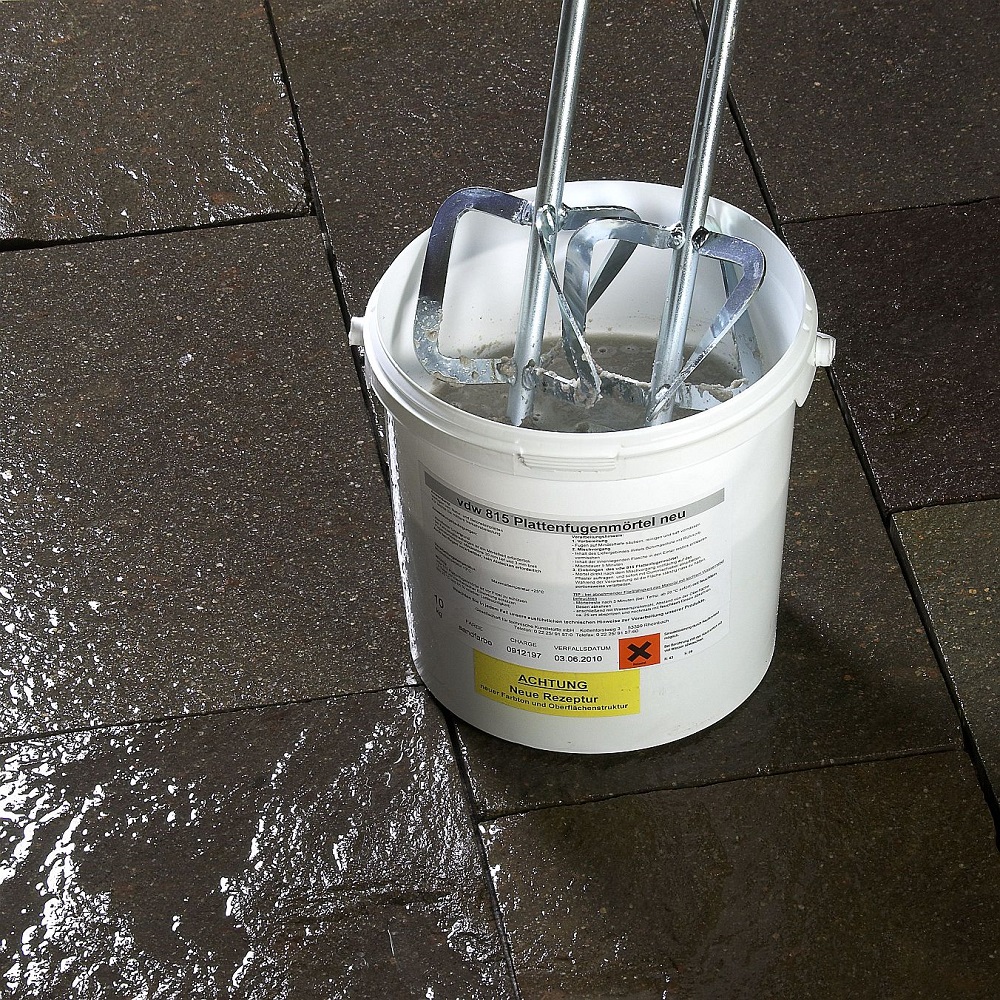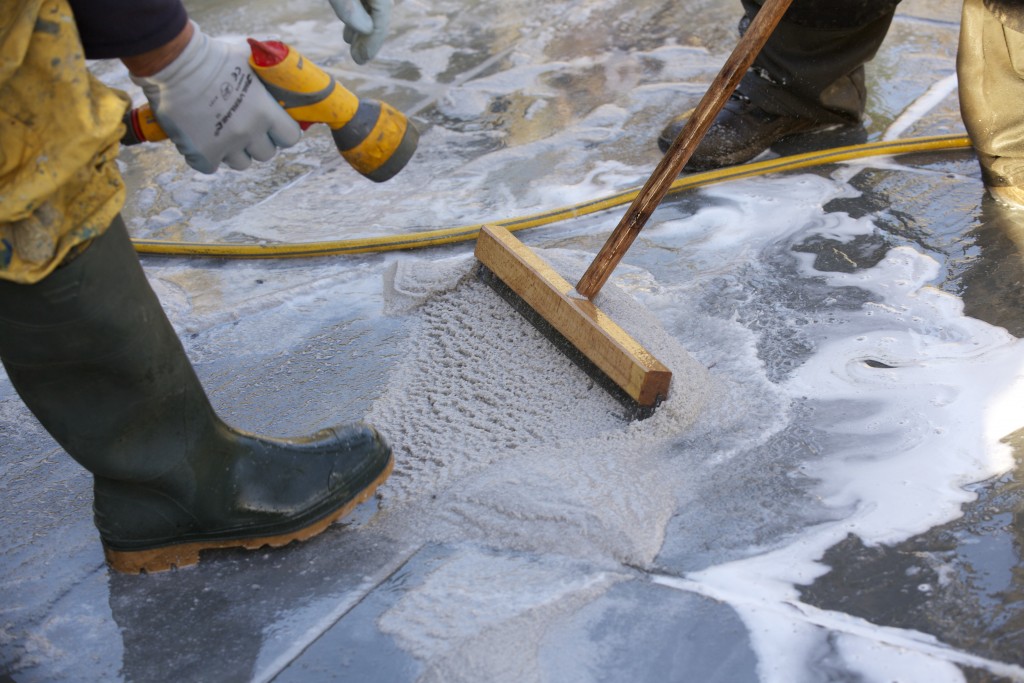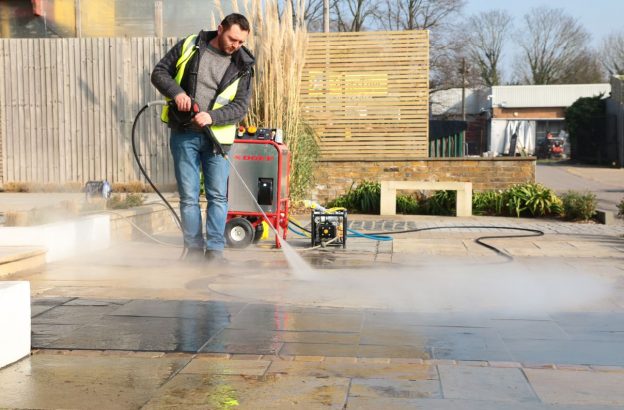Choosing the right patio grouting for your exterior paving or the right tile grout in your bathroom and kitchen can be confusing. We talk you through the best products available so you can make the right choice.
After a lot of time researching and testing all the pointing products available, we now supply a range of market-leading pointing products, each aimed at a specific look and/or application.
To help you choose the best product for you, we talk you through the different pointing and grouting solutions we supply in the following sections:
Patio grouting for external paving
Comparison table of pointing and grouting for natural stone and porcelain
How to choose patio grouting
1. Are you pointing natural stone or porcelain?
If porcelain, it’s best practice to use a non-permeable pointing material. This is because there is a slim chance of porcelain paving—which has very low porosity—popping from the mortar bed. This is caused by moisture migrating between the paving and the mortar bed and then freezing and expanding in the winter. This process is called freeze/thaw. One way to avoid this is to use a non-permeable pointing material.
For the same reason, non-permeable pointing is a good choice for very dense stones such as Jura Limestone or Travertine.
Non-permeable pointing includes the Norcros Grouts, Flowpoint, Larsen Gun Pointing Mortar, Fugabella and Fuga Pave.
2. Is it for interior or external use?
This is really another way of asking whether you want permeable or impermeable pointing. While non-permeable pointing is the best choice for porcelain, it’s also the number one choice for indoor areas—where you definitely don’t want water to penetrate into the substrate.
Outside, permeable pointing assists drainage. GftK and EASYjoint are permeable.
3. Do you want an exact match, a contrast, or a colour that blends with your paving?
The choice of colours varies from range to range, so if an exact match is desired, it’s worth browsing all the options. For an extremely wide range of colours, Fugabella offers fifty different shades. If necessary, it’s also possible to mix colours from within the same range to create an exact match for your choice of tile or paving.
In our experience, when clients are looking to achieve a modern, uniform look, they often opt for a jointing material that is as close as possible to the paving colour. It’s obviously down to personal taste, but we don’t see clients going for contrasting colours very often these days. If in doubt, you can’t go wrong with grey.
Misused, a jetwash can apply a great amount of pressure to pointing—pressure that quickly wears it away and will break it up. Used properly, jetwashing will still, over time, take its toll on most pointing. However, when installed correctly, the majority of pointing products should last a number of years.
The exception to this is GftK. This features a 2-part epoxy resin that offers a completely bomb-proof finish. This product can be jetwashed regularly and is one of the main reasons that it's commonly used on commercial paving schemes.
Time was, when the only option for pointing was to get down on hands and knees and trowel it in. Nowadays, there’s a wide choice of sweep-in mortars, applied with gallons of water and a rubber squeegee, from a standing position. We can’t over-state what a game-changer these sweep-in products have been for the well-being of paving contractors. Spending all day on your knees can be crippling over time. Thank goodness pavers are not forced to do this anymore.
Trowelling is very hard work. Some people still prefer to do this, but usually for smaller jobs. Brush-in options tend to cost a little more, but save time in the speed of application.
While everyone has their own preference, and we carry different options to reflect that, we would recommend brush-in every time. Your body will thank you for it.
7. Have you access to copious amounts of water?
For sweep-in resin compounds, such as GftK, to avoid staining the paving you must saturate the area before and throughout the whole installation process. Don’t worry about oversoaking the paving, it’s impossible to use too much water. So, if the paving area is unreachable with a hose, choose a different pointing option.
8. How experienced are you?
Some of the pointing options, such as Flowpoint, have to be applied very quickly and deftly before they start to “cure”, or set. Grouts with a longer working time are more forgiving to the amateur and less experienced contractor.
Don’t forget that a bad job on the pointing makes a bad job of the entire project, so only use jointing materials that you are comfortable with. London Stone provide full training in the use of all our pointing products. If you, or a member of your team, would be interested in having pointing training, speak to a member of our team.
Patio grouting recommended for external paving
Larsen Colourfast 360 Grout

Value-for-money, with a good range of popular colours to choose from, Larsen Colourfast 360 Grout is one we recommend for our porcelain paving. We also recommend it for use with our indoor tiling. Cement-based and impermeable, it’s versatile enough for use in joints as fine as 1mm, up to a maximum of 15mm.
Application is with a tile float and, once mixed, it has a pot life of 40 minutes. Its fine texture gives a smooth finish that complements modern paving and is stain-, mould- and water-resistant.
Flowpoint Rapid Setting Grout

Flowpoint Rapid-Set Grout is, like Norcros, a cement-based, non-permeable sweep-in grout. However, unusually for sweep-in pointing, it has a finer-grained finish. Its other advantage, although this can be a hindrance too, is that it sets rapidly.
Flowpoint can take foot-traffic after an hour, and vehicle traffic after just four hours. It's suitable for joints from 5mm to a very wide 50mm and up to 200mm deep.
Applied with a rubber float, it’s not recommended for the amateur. It needs to be used quickly and moved constantly over the surface of the paving to ensure joints are fully topped up before it begins to harden, as the initial set occurs after 15 minutes at 20 C.
More expensive than Norcros, it can prove cost-effective with its exceptional bond strength and is suitable for large-scale commercial schemes as well as domestic situations.
You might like to watch this comprehensive video on using Flowpoint.
GftK Joint Mortars

GftK, a two-part epoxy resin-based, brush-in pointing, offers an altogether more traditional look with a slightly grainy appearance that’s ideal for riven sandstone and slate, tumbled sandstone, and stone that offers a more rustic feel. It is possible to achieve a smoother finish by trowelling it in, but this negates its sweep-in advantages! It’s also permeable.
Available in three colours to blend with natural stone colours, it can nevertheless be used with any stone, and might surprise you with its versatility. Our Customer Experience Director, Chris Durnford, said, “Not all people like the slightly grainy aspect, but I saw it in combination with sawn Yorkstone recently and it looks really good.”
Added advantages are that it works well with wider joints and can be used in virtually all weathers—quite handy for the UK. The area worked must be kept wet—the wetter, the better, say the folks at GftK.

The difference between GftK vdw 815 and GftK vdw 850 is the grain of finish. The vdw 815 is suitable for narrow joints down to 3mm wide and vdw 850 for larger joints from 5mm.
For more information see The Advantages of GftK Joint Mortars.
Larsen Gun Pointing Mortar

For sawn paving, Larsen Gun Pointing Mortar, supplied in four colours, offers a very smooth finish that acts as an ideal foil to defined edges. Its gun application, where you squeeze the grout into the joints, is preferred by some for the control it gives in applying the pointing. It requires a bit more time but gives a very precise edge.
Beware of picture framing with this product. This occurs when the thirsty stone sucks moisture out of the pointing, causing a picture-framing effect around the edge of the stone. The best way to avoid this is by making the stone damp prior to pointing. Don't soak the stone as this might dilute the grout. Making the stone noticeably damp ensures that the pores of the stone already contain water and so don't draw additional moisture from the Larsen.
Fugabella Outdoor Grout

Fugabella Outdoor Grout has a very fine-grained finish that works well with porcelain tiles and paving and DesignClad, as well as dense, smooth natural stone like sawn limestone and Brazilian slate.
Technically advanced, it offers a superior depth of colour and is very easy to clean off, which reduces the chance of grout haze. We supply Fugabella in the four colours that we feel are most suitable to our porcelain paving range. However, there are up to 50 colours available, so designers and contractors can be very creative with this product.
It can also be used for internal tiles, but may create difficulties because its lengthy curing time means that floors cannot be walked on for 24 hours.
Fuga-Pave Grout

EasyJoint Patio Pointing Mortar

EASYJoint is a long-established and popular sweep-in resin product suitable for natural stone. Because it’s a one-part epoxy-resin compound, it’s much cheaper than GftK; it's also more user-friendly, as it doesn’t require mechanical mixing. This make it a popular product for DIY use.
However, there are a couple of considerations. The site it’s intended for must be free-draining and the bedding material permeable. This is to ensure water drains away as, if water remains in the joint, it will cause it to deteriorate quickly.
You should also consider where you want to use it. As a 1-part pointing product, it doesn’t have the same durability as 2-part epoxy-resin products. It depends on usage, but it may need attention after two or three years—and extra care should be taken when jetwashing. We would recommend EASYjoint as a very good, budget-conscious choice for small DIY projects and low-use areas that won’t demand a lot of cleaning.
When installing, it’s impossible to use too much water, and easier if you have someone to help. See this installation video for more information.
Grout recommended for Internal Tiling
Larsen Colourfast 360 Grout
As listed above, this is also suitable for external tiling. Its fine grain and smooth finish, along with the extremely fine joints that its texture permits, make it an ideal choice for indoor tiling, however. It cures within 1-2 hours at 20°C and can take light foot traffic after 3 hours, which limits inconvenience when installing internal floors.
Comparison table of pointing and grouting for natural stone and porcelain



/filters:quality(40)/mediadev/media/homepage/price_right_arrow.svg)
/filters:quality(60)/mediadev/media/menu-pics/menu_banner_mobile.png )
/filters:quality(60)/mediadev/media/menu-pics/all-porcelain.jpg )
/filters:quality(60)/mediadev/media/menu-pics/luxury-italian.jpg )
/filters:quality(60)/mediadev/media/menu-pics/premium-italian.jpg )
/filters:quality(60)/mediadev/media/menu-pics/budget-porcelain.jpg )
/filters:quality(60)/mediadev/media/menu-pics/large-format-porcelain.jpg )
/filters:quality(60)/mediadev/media/menu-pics/wood-effect-porcelain.jpg )
/filters:quality(60)/mediadev/media/menu-pics/porcelain-planks.jpg )
/filters:quality(60)/mediadev/media/menu-pics/porcelain-setts.jpg )
/filters:quality(60)/mediadev/media/menu-pics/browse-all-paving.jpg )
/filters:quality(60)/mediadev/media/menu-pics/stone-paving.jpg )
/filters:quality(60)/mediadev/media/menu-pics/interior-tiles.jpg )
/filters:quality(60)/mediadev/media/menu-pics/stone-effect-porcelain.png )
/filters:quality(60)/mediadev/media/menu-pics/wood-effect-porcelain.png )
/filters:quality(60)/mediadev/media/menu-pics/grey-porcelain.png )
/filters:quality(60)/mediadev/media/menu-pics/beige-porcelain.png )
/filters:quality(60)/mediadev/media/menu-pics/dark-porcelain.png )
/filters:quality(60)/mediadev/media/menu-pics/light-porcelain.png )
/filters:quality(60)/mediadev/media/menu-pics/patio-grout.jpg)
/filters:quality(60)/mediadev/media/menu-pics/primers.jpg)
/filters:quality(60)/mediadev/media/menu-pics/porcelain-blades.jpg)
/filters:quality(90)/mediadev/media/menu-pics/drainage.jpg)
/filters:quality(60)/mediadev/media/menu-pics/cleaners.jpg)
/filters:quality(60)/mediadev/media/menu-pics/all-stone-paving.jpg )
/filters:quality(60)/mediadev/media/menu-pics/all-sawn-paving.jpg )
/filters:quality(60)/mediadev/media/menu-pics/all-riven-paving.jpg )
/filters:quality(60)/mediadev/media/menu-pics/indian-sandstone.jpg )
/filters:quality(60)/mediadev/media/menu-pics/limestone-paving.jpg )
/filters:quality(60)/mediadev/media/menu-pics/granite-paving.jpg )
/filters:quality(60)/mediadev/media/menu-pics/slate-paving.jpg )
/filters:quality(60)/mediadev/media/menu-pics/yorkstone-paving.jpg )
/filters:quality(60)/mediadev/media/menu-pics/stone-pavers.jpg )
/filters:quality(60)/mediadev/media/menu-pics/cobbles-setts.jpg )
/filters:quality(60)/mediadev/media/menu-pics/plank-paving.jpg )
/filters:quality(60)/mediadev/media/menu-pics/paving-circles.jpg )
/filters:quality(60)/mediadev/media/menu-pics/bespoke-paving-1.jpg )
/filters:quality(60)/mediadev/media/menu-pics/edging-stones-1.jpg )
/filters:quality(60)/mediadev/media/menu-pics/prestige-stone.jpg )
/filters:quality(60)/mediadev/media/menu-pics/grey-blue-stone.png)
/filters:quality(60)/mediadev/media/menu-pics/swatch-black-dark.jpg )
/filters:quality(60)/mediadev/media/menu-pics/swatch-buff-beige-white.jpg )
/filters:quality(60)/mediadev/media/menu-pics/sealants.jpg)
/filters:quality(60)/mediadev/media/menu-pics/all-clay-paving.jpg )
/filters:quality(60)/mediadev/media/menu-pics/alpha-clay-pavers.jpg )
/filters:quality(60)/mediadev/media/menu-pics/cottage-garden-clay-pavers.jpg )
/filters:quality(60)/mediadev/media/menu-pics/kessel-garden-clay-pavers.jpg )
/filters:quality(60)/mediadev/media/menu-pics/artisan-clay-pavers.jpg )
/filters:quality(60)/mediadev/media/menu-pics/grey-blue-clay-paver.png )
/filters:quality(60)/mediadev/media/menu-pics/red-brown-clay-pavers.png )
/filters:quality(60)/mediadev/media/menu-pics/beige-buff-clay-pavers.png )
/filters:quality(60)/mediadev/media/menu-pics/composite-decking.jpg )
/filters:quality(60)/mediadev/media/menu-pics/designboard-decking.jpg )
/filters:quality(60)/mediadev/media/menu-pics/classic-designboard.jpg )
/filters:quality(60)/mediadev/media/menu-pics/brushed-designboard.jpg )
/filters:quality(60)/mediadev/media/menu-pics/grooved-designboard.jpg )
/filters:quality(60)/mediadev/media/menu-pics/millboard-decking.jpg )
/filters:quality(60)/mediadev/media/menu-pics/grey-decking.jpg )
/filters:quality(60)/mediadev/media/menu-pics/black-charcoal-decking.jpg)
/filters:quality(60)/mediadev/media/menu-pics/brown-decking.jpg)
/filters:quality(60)/mediadev/media/menu-pics/all-build-deck.png )
/filters:quality(60)/mediadev/media/menu-pics/stone-cladding.jpg )
/filters:quality(60)/mediadev/media/menu-pics/all-garden-walling-1.jpg )
/filters:quality(60)/mediadev/media/menu-pics/facing-bricks.jpg )
/filters:quality(60)/mediadev/media/menu-pics/garden-screening.jpg )
/filters:quality(60)/mediadev/media/menu-pics/menu_Garden_banner_desk.png )
/filters:quality(60)/mediadev/media/menu-pics/all-steps-coping.jpg )
/filters:quality(60)/mediadev/media/menu-pics/stone-garden-steps.jpg )
/filters:quality(60)/mediadev/media/menu-pics/sawn-steps.jpg )
/filters:quality(60)/mediadev/media/menu-pics/riven-steps.jpg )
/filters:quality(60)/mediadev/media/menu-pics/yorkstone-steps.jpg )
/filters:quality(60)/mediadev/media/menu-pics/bespoke-steps.jpg )
/filters:quality(60)/mediadev/media/menu-pics/porcelain-steps.jpg )
/filters:quality(60)/mediadev/media/menu-pics/off-the-shelf.jpg )
/filters:quality(60)/mediadev/media/menu-pics/stone-coping.jpg )
/filters:quality(60)/mediadev/media/menu-pics/sawn-coping.jpg )
/filters:quality(60)/mediadev/media/menu-pics/riven-coping.jpg )
/filters:quality(60)/mediadev/media/menu-pics/yorkstone-coping.jpg )
/filters:quality(60)/mediadev/media/menu-pics/bespoke-coping.jpg )
/filters:quality(60)/mediadev/media/menu-pics/stone-pier-caps.jpg )
/filters:quality(60)/mediadev/media/menu-pics/porcelain-coping.jpg )
/filters:quality(60)/mediadev/media/menu-pics/all-bespoke-services.jpg )
/filters:quality(60)/mediadev/media/menu-pics/bespoke-paving-2.jpg )
/filters:quality(60)/mediadev/media/menu-pics/bespoke-steps-1.jpg )
/filters:quality(60)/mediadev/media/menu-pics/bespoke-coping-1.jpg )
/filters:quality(60)/mediadev/media/menu-pics/edge-profiles.jpg )
/filters:quality(60)/mediadev/media/menu-pics/masonry-services.jpg )
/filters:quality(60)/mediadev/media/menu-pics/deluxe-pergolas.jpg )
/filters:quality(60)/mediadev/media/menu-pics/proteus-pergolas.jpg )
/filters:quality(60)/mediadev/media/menu-pics/corten_planter_menu.png )
 Trade Discount Available
Trade Discount Available FREE Nationwide Delivery
FREE Nationwide Delivery Nationwide Showrooms
Nationwide Showrooms Live Stock Levels
Live Stock Levels Split Packs Available
Split Packs Available


